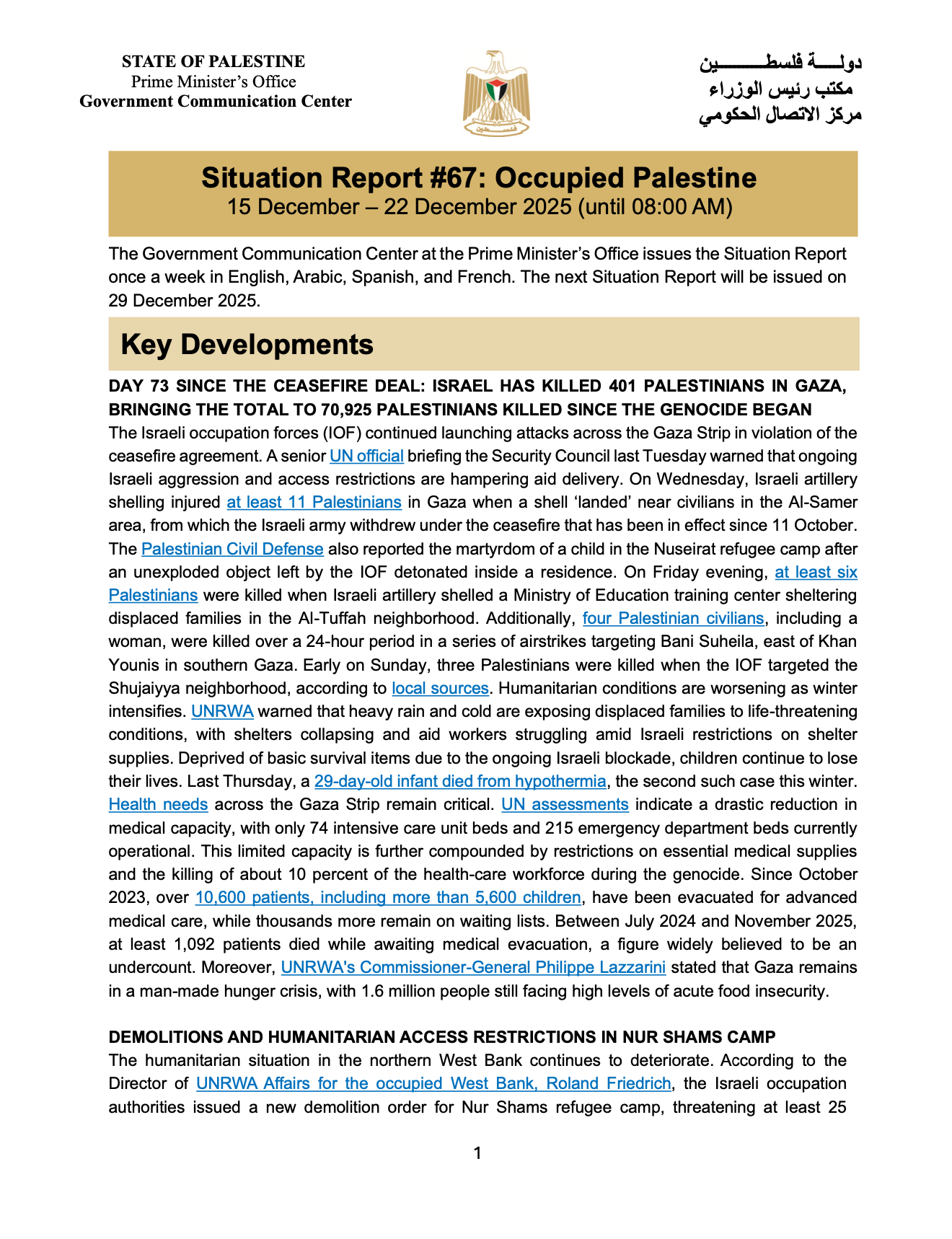RAMALLAH, October 6, 2025 (WAFA) – The Palestinian Central Bureau of Statistics (PCBS) noted that Israeli aggression on the Gaza Strip has caused damages to 190,115 buildings in a report titled "Housing in Gaza: Between Rubble and Displacement: Destroyed Houses and Displaced Families Searching for Shelter."
World Habitat Day is marked on the first Monday of October each year and is recognized by the United Nations/UN-Habitat, alongside Arab Housing Day, endorsed by the Council of Arab Ministers of Housing and Reconstruction.
The day provides an opportunity to reflect on housing conditions and highlight the challenges and opportunities facing cities.
The Global Observance of World Habitat Day will be under the theme “Urban Crisis Response”. The theme will focus on addressing multiple crises affecting cities, including conflicts that contribute to exacerbating such crises.
On this occasion, the Palestinian Central Bureau of Statistics presents key indicators on housing conditions in Palestine, shedding light on the ongoing challenges faced by Palestinians amid two consecutive years of the Israeli aggression since October 7th, 2023.
The Israeli Occupation Expands the Circle of Destruction: a Massive Increase in the Number of Damaged Buildings in Gaza Strip as a Result of the Brutal Aggression.
The number of damaged buildings as a result of the Israeli aggression against Gaza Strip from 07/10/2023 to 08/07/2025 reached 190,115 buildings, including 102,067 completely demolished buildings; a double figure of the figure during the first year of the Israeli aggression, while the number of moderately damaged buildings stood at 41,895, and the number of damaged housing units amounted to about 330,500 housing units.
Palestinians in the West Bank, including Jerusalem Governorate, are subjected to increased forced displacement
Since October 2023 until 31/05/2025, Israel has intensified forced displacement and land confiscation across the occupied West Bank and Jerusalem Governorate. In Masafer Yatta, around 1,200 Palestinians face displacement after the Israeli authorities rejected all building permits under the pretext of “military training” zones, while settlers nearby remain unaffected. According to OCHA, at least 6,463 Palestinians have been displaced by demolitions in addition to another 40,000 from the refugee camps in both Jenin and Tulkarm cities due to military operations. In addition to over 2,200 Palestinians facing displacements by settler violence and access restrictions.
In the same context, and according to the Colonization and Wall Resistance Commission, data stated that during the first half of 2025, the Israeli occupation carried out 380 demolition operations, and 588 establishments were demolished in the West Bank, including 322 inhabited residences, including Jerusalem city with 67 demolition operations, and 79 demolished establishments. These measures, which strip Palestinians of their homes and lands, constitute a violation of the human right to housing.
Large-scale Displacement amid the Ongoing Israeli Military Operation and Aggression in Gaza City
Since October 7th, 2023, Gaza Strip has faced brutal aggression and systematic genocide, causing massive forced displacement of more than 2 million people until 11/07/2025, while estimates indicated that over one million residents/displaced people were living in densely populated tented areas and in what is left of habitable buildings in northern Gaza.
UN Satellite Centre imagery between September 4th and 15th, 2025, showed that thousands of tents established on empty lots among the ruins of Gaza City, along the coast, and in less urbanized areas of the north, had either disappeared or dramatically decreased in number.
However, Planet Labs PBC satellite on September 15th, 2025, shows tent camps remain dotted along the coastal road south of Gaza's port, even though the Israeli military said around 400,000 Palestinians have evacuated their places upon its mandatory order of leaving, yet over half a million are estimated to be still in northern Gaza.
5% of Households in the West Bank Live in Overcrowded Housing Units
Data indicated that 5% of the households in the West Bank live in housing units with three persons or more per room, and by type of locality: 4.8% of the households in urban areas, 3.6% in rural areas, and 10.5% in refugee camps in 2024.
Data indicated that the average number of rooms in a housing unit in the West Bank was 3.6 rooms in 2024 (3.6 rooms in urban areas and 3.7 rooms in rural areas, compared to 3.2 rooms in refugee camps.
Gaza Strip: More than 85% of Water and Sanitation Facilities and Assets have been Completely or Partially out of Service in Gaza Strip
As a result of the Israeli occupation aggression more than 85% of water and sanitation facilities and assets have been completely or partially out of service and require rehabilitation exceeding one and a half billion dollars, including sewage treatment plants, desalination plants, pumping stations, wells, water tanks, main transmission lines, water and sanitation networks, and more, so the per capita share of water in Gaza does not exceed half of the estimated minimum humanitarian requirement in emergency situations, which is 15 liters per person per day.
Due to the extensive damage incurred by the water and sanitation sector, water supply rates have declined to an average of 3-5 liters per person per day.
Decrease in the Number of Licensed Housing Units for 2024 Compared with Previous Years
The number of new and existing licensed housing units for 2024 reached 13,819 licensed housing units in Palestine, compared to 18,230 licensed housing units in 2023, according to the administrative records of building licenses in 2023 and 2024.
In the Palestinian context, World Habitat Day takes on a special significance, as the Palestinian people live under overlapping challenges of conflict and forced displacement resulting from the occupation, alongside economic pressures and the impacts of climate change.
These conditions place increasing burdens on cities and urban areas in providing adequate housing and essential services, particularly amid urban expansion and a growing population under the Israeli occupation control of Palestinian resources and capacities. This day underscores the urgent need to adopt sustainable urban solutions that balance the needs of both residents and displaced persons. Addressing the housing crisis in Palestine is not merely a matter of immediate humanitarian response, but requires a long-term developmental vision that ensures the Palestinian people's right to live with dignity, access safe shelter, and enjoy spatial justice that strengthens resilience and stability.
Y.S










